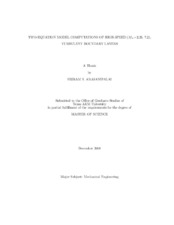| dc.contributor.advisor | Anand, N.K. | |
| dc.contributor.advisor | Girimaji, Sharath S. | |
| dc.creator | Arasanipalai, Sriram Sharan | |
| dc.date.accessioned | 2010-01-15T00:06:53Z | |
| dc.date.accessioned | 2010-01-16T01:24:19Z | |
| dc.date.available | 2010-01-15T00:06:53Z | |
| dc.date.available | 2010-01-16T01:24:19Z | |
| dc.date.created | 2008-12 | |
| dc.date.issued | 2009-05-15 | |
| dc.identifier.uri | https://hdl.handle.net/1969.1/ETD-TAMU-3186 | |
| dc.description.abstract | The objective of this research is to assess the performance of two popularReynolds-averaged Navier-Stokes (RANS) models, standard k-E and k-w, andto suggest modifications to improve model predictions for high-speed flows. Numerical simulations of turbulent ow past a at plate are performed at M1 = 2:25; 7:2.The results from these two Mach number cases are compared with Direct NumericalSimulation (DNS) results from Pirozzoli et al. (2004) and experimental results fromHorstman & Owen (1975). The effect of the Boussinesq coefficient (Cu) and turbulenttransport coefficients (sigmak; sigmaE; sigma; sigma*) on the boundary layer ow is examined. Further,the performance of a new model with realizability-based correction to Cu and corresponding modifications to sigma; sigma* is examined. The modification to Cu is based oncontrolling the ratio of production to dissipation of kinetic energy (P/E=1). The firstchoice of P/E = 1 ensures that there is no accumulation of kinetic energy in stagnation or free-stream regions of the ow. The second choice of P/E= 1:6 holds underthe assumption of a homogeneous shear ow. It is observed that the new model'sperformance is similar to that of the existing RANS models, which is expected for asimple ow over a at plate. Finally, the role of turbulent Prandtl number (Prt) intemperature and density predictions is established. The results indicate that the k-wmodel's performance is better compared to that of the standard k-E model for highMach number flows. A modification to Cu must be accompanied with correspondingchanges to sigmak; sigmaE; sigma; sigma* for an accurate log-layer prediction. The results also indicate that a Prt variation is required across the boundary layer for improved temperatureand density predictions in high-speed flows. | en |
| dc.format.medium | electronic | en |
| dc.format.mimetype | application/pdf | |
| dc.language.iso | en_US | |
| dc.subject | high-speed flows | en |
| dc.subject | realizablity | en |
| dc.subject | turbulent Prandtl number | en |
| dc.title | Two-equation model computations of high-speed (ma=2.25, 7.2), turbulent boundary layers | en |
| dc.type | Book | en |
| dc.type | Thesis | en |
| thesis.degree.department | Mechanical Engineering | en |
| thesis.degree.discipline | Mechanical Engineering | en |
| thesis.degree.grantor | Texas A&M University | en |
| thesis.degree.name | Master of Science | en |
| thesis.degree.level | Masters | en |
| dc.contributor.committeeMember | Bowersox, Rodney. | |
| dc.type.genre | Electronic Thesis | en |
| dc.type.material | text | en |
| dc.format.digitalOrigin | born digital | en |


